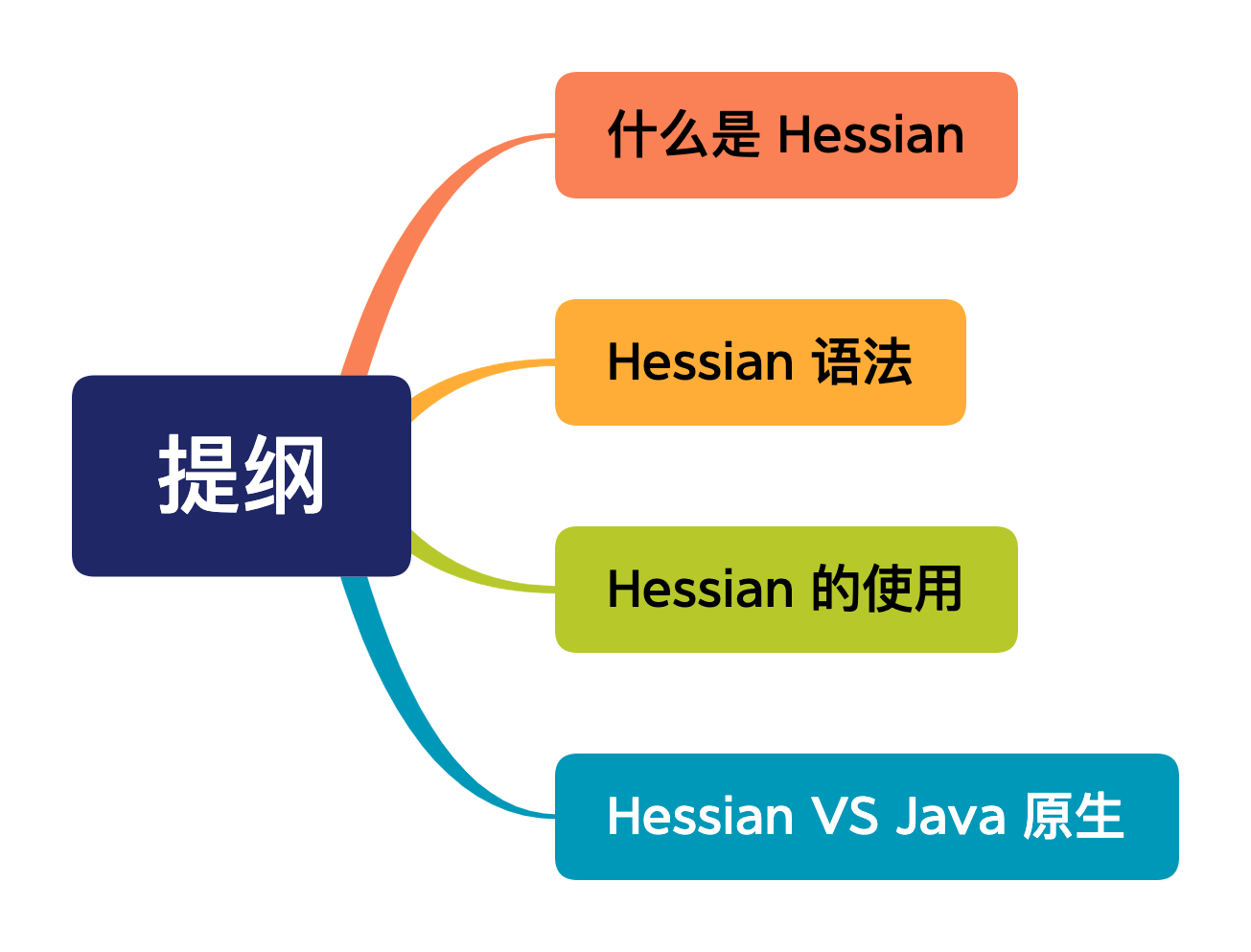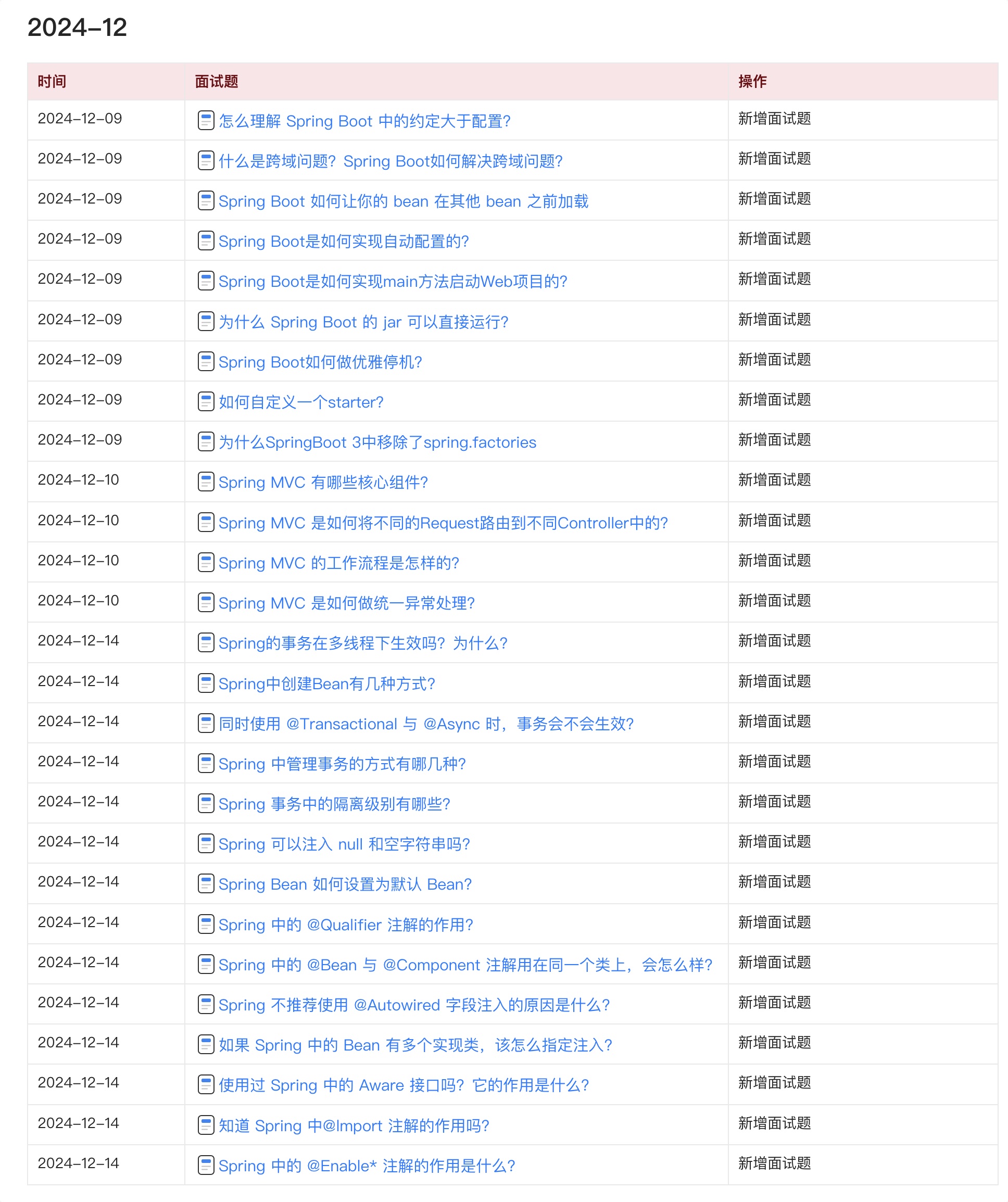在 Java 序列化之深入理解 Java 序列化和反序列化 一文中,大明哥说到,Java 的原生序列化存在三个缺点:
- 无法跨语言
- 序列化后的字节流太大
- 序列化时间太长
这三个缺陷是我们在开发过程中是无法容忍的,所以我们必须来寻找一个可替代的方案。Hessian 就是一个不错的选择。

什么是 Hessian
Hessian 是一种动态类型、二进制序列化和 Web 服务协议,专为面向对象的传输而设计。
与 Java 原生序列化类似,Hessian 也是采用二进制协议,不过它比 Java 原生序列化的性能更加高,序列化的字节数也更小。
与 Java 原生序列化相比,Hessian 具有如下几个特点(http://hessian.caucho.com/doc/hessian-serialization.html):
- 它必须自我描述序列化类型,即不需要外部模式或接口定义
- 它必须是独立于语言的,包括支持脚本语言
- 它必须是可以通过单一方式进行读写
- 它必须尽可能紧凑
- 它必须简单,这样才能有效地测试和实现
- 必须尽可能地快
- 它必须支持Unicode字符串
- 它必须支持8位二进制数据,而不需要转义或使用附件
- 它必须支持加密、压缩、签名和事务上下文信封
目前 Hessian 已经到 2.0 版本了,相比 1.0 版本,Hessian 2.0 版本增加了压缩编码,其序列化二进制流大小事 Java 序列化的 50%,序列化耗时是 Java 序列化的 30%,反序列化耗时是 Java 序列化的20%。
Hessian 语法
Hessian 序列化的字节数更加小,与它的实现序列化的语法密不可分,如下:
# starting production
top ::= value
# 8-bit binary data split into 64k chunks
binary ::= x41 b1 b0 <binary-data> binary # non-final chunk
::= 'B' b1 b0 <binary-data> # final chunk
::= [x20-x2f] <binary-data> # binary data of
# length 0-15
::= [x34-x37] <binary-data> # binary data of
# length 0-1023
# boolean true/false
boolean ::= 'T'
::= 'F'
# definition for an object (compact map)
class-def ::= 'C' string int string*
# time in UTC encoded as 64-bit long milliseconds since
# epoch
date ::= x4a b7 b6 b5 b4 b3 b2 b1 b0
::= x4b b3 b2 b1 b0 # minutes since epoch
# 64-bit IEEE double
double ::= 'D' b7 b6 b5 b4 b3 b2 b1 b0
::= x5b # 0.0
::= x5c # 1.0
::= x5d b0 # byte cast to double
# (-128.0 to 127.0)
::= x5e b1 b0 # short cast to double
::= x5f b3 b2 b1 b0 # 32-bit float cast to double
# 32-bit signed integer
int ::= 'I' b3 b2 b1 b0
::= [x80-xbf] # -x10 to x3f
::= [xc0-xcf] b0 # -x800 to x7ff
::= [xd0-xd7] b1 b0 # -x40000 to x3ffff
# list/vector
list ::= x55 type value* 'Z' # variable-length list
::= 'V' type int value* # fixed-length list
::= x57 value* 'Z' # variable-length untyped list
::= x58 int value* # fixed-length untyped list
::= [x70-77] type value* # fixed-length typed list
::= [x78-7f] value* # fixed-length untyped list
# 64-bit signed long integer
long ::= 'L' b7 b6 b5 b4 b3 b2 b1 b0
::= [xd8-xef] # -x08 to x0f
::= [xf0-xff] b0 # -x800 to x7ff
::= [x38-x3f] b1 b0 # -x40000 to x3ffff
::= x59 b3 b2 b1 b0 # 32-bit integer cast to long
# map/object
map ::= 'M' type (value value)* 'Z' # key, value map pairs
::= 'H' (value value)* 'Z' # untyped key, value
# null value
null ::= 'N'
# Object instance
object ::= 'O' int value*
::= [x60-x6f] value*
# value reference (e.g. circular trees and graphs)
ref ::= x51 int # reference to nth map/list/object
# UTF-8 encoded character string split into 64k chunks
string ::= x52 b1 b0 <utf8-data> string # non-final chunk
::= 'S' b1 b0 <utf8-data> # string of length
# 0-65535
::= [x00-x1f] <utf8-data> # string of length
# 0-31
::= [x30-x34] <utf8-data> # string of length
# 0-1023
# map/list types for OO languages
type ::= string # type name
::= int # type reference
# main production
value ::= null
::= binary
::= boolean
::= class-def value
::= date
::= double
::= int
::= list
::= long
::= map
::= object
::= ref
::= string
举几个例子:
- boolean
Boolean 的语法如下:
boolean ::= T
::= F
T 代表 true,F 代表 false。
用如下代码演示下:
hessianOutput.writeObject(true);
System.out.println("序列化:" + Arrays.toString(bos.toByteArray()));
// --运行结果
序列化:[84]
84 的 ASCII 为 T。
- int
Integer 语法如下:
int ::= 'I' b3 b2 b1 b0
::= [x80-xbf]
::= [xc0-xcf] b0
::= [xd0-xd7] b1 b0
一个 32 位有符合的整数,它由八位数x49('I')表示,后面是整数的4个八位数,以高位优先(big-endian)顺序排列。其中 value = (b3 << 24) + (b2 << 16) + (b1 << 8) + b0
用如下代码演示下:
hessianOutput.writeObject(1024);
System.out.println("序列化:" + Arrays.toString(bos.toByteArray()));
// --运行结果
序列化 :[73, 0, 0, 4, 0]
73 的 ASCII 为 I,4 << 8 就等于 1024。
- 对象
对象的语法如下:
class-def ::= 'C' string int string*
object ::= 'O' int value*
::= [x60-x6f] value*
它的表示也很简单:
class Car {
String color;
String model;
}
out.writeObject(new Car("red", "corvette"));
out.writeObject(new Car("green", "civic"));
---
C # 类的描述信息
x0b example.Car # type is example.Car
x92 # two fields
x05 color # color field name // 属性名
x05 model # model field name // 属性名
O # object def (long form)
x90 # object definition #0
x03 red # color field value // 属性值
x08 corvette # model field value // 属性值
x60 # object def #0 (short form)
x05 green # color field value // 属性值
x05 civic # model field value // 属性值
更多详情请参考官方文档:http://hessian.caucho.com/doc/hessian-serialization.html
Hessian 的使用
- 先引入包,大明哥在写这篇文章的时候,最新版本为,4.0.65
<dependency>
<groupId>com.caucho</groupId>
<artifactId>hessian</artifactId>
<version>4.0.65</version>
</dependency>
- 序列化对象实现 Serializable 接口
public class Student implements Serializable {
private String name;
private int age;
private Integer height;
private transient String gender;
}
- Hessian 序列化
public class Hessian02Test {
public static void main(String[] args) throws IOException {
Student student1 = new Student("张三",18,180,"男");
// 序列化
ByteArrayOutputStream bos = new ByteArrayOutputStream();
HessianOutput hessianOutput = new HessianOutput(bos);
hessianOutput.writeObject(student1);
System.out.println("序列化内容:" + Arrays.toString(bos.toByteArray()));
//反序列化
ByteArrayInputStream bis = new ByteArrayInputStream(bos.toByteArray());
HessianInput hessianInput = new HessianInput(bis);
Student student2 = (Student) hessianInput.readObject();
System.out.println("反序列化内容:" + student2);
}
}
- 执行结果
序列化内容:[77, 116, 0, 48, 99, 111, 109, 46, 115, 105, 107, 101, 46, 106, 97, 118, 97, 99, 111, 114, 101, 46, 115, 101, 114, 105, 97, 108, 105, 122, 101, 114, 46, 104, 101, 115, 115, 105, 97, 110, 46, 100, 116, 111, 46, 83, 116, 117, 100, 101, 110, 116, 83, 0, 4, 110, 97, 109, 101, 83, 0, 2, -27, -68, -96, -28, -72, -119, 83, 0, 3, 97, 103, 101, 73, 0, 0, 0, 18, 83, 0, 6, 104, 101, 105, 103, 104, 116, 73, 0, 0, 0, -76, 122]
反序列化内容:Student(name=张三, age=18, height=180, gender=null)
从执行结果来看,反序列化完美将 Student 对象还原了。
这里需要注意的是,无论是 Java 原生序列化还是 Hessian 序列化,对象都必须实现 Serializable 接口,否则会报 must implement java.io.Serializable 异常。
与 Java 原生序列化一样,用 transient 标识的属性是不需要序列化和反序列化的。
还有一点,若对象经过 Hessian 序列化后,在不加 serialVersionUID 的情况下,我们改变该对象的属性都不会引起 Hessian 反序列化失败,所以 Hessian 序列化对象不需要再使用 serialVersionUID 来标注对象版本了。
我们再看一个稍微复杂的对象。
public class SubStudent extends Student{
private Integer height;
private String subValue;
}
SubStudent 继承 Student,并且拥有同一个属性 height。我们对 SubStudent 进行序列化和反序列化。
public class Hessian03Test {
public static void main(String[] args) throws IOException {
SubStudent subStudent = new SubStudent();
subStudent.setName("李四");
subStudent.setHeight(185);
subStudent.setSubValue("lisi");
subStudent.setGender("男");
// 序列化
ByteArrayOutputStream bos = new ByteArrayOutputStream();
HessianOutput hessianOutput = new HessianOutput(bos);
hessianOutput.writeObject(subStudent);
//反序列化
ByteArrayInputStream bis = new ByteArrayInputStream(bos.toByteArray());
HessianInput hessianInput = new HessianInput(bis);
SubStudent student2 = (SubStudent) hessianInput.readObject();
System.out.println("反序列化内容:" + student2);
}
}
运行结果
反序列化内容:SubStudent(height=null, subValue=lisi)
从反序列化结果我们看到 height 属性值为 null,但是我们明明对其值设置为 185 ,在反序列化时怎么会是 0 呢?这其实是与 Hessian 对复杂对象的处理逻辑相关:Hessian 会把复杂对象的所有属性存储在一个 Map 中进行序列化。所以在父类、子类中存在同名成员变量的情况下,Hessian 序列化时,先序列化子类,然后序列化父类。因此,反序列化结果会导致子类同名成员变量被父类的值覆盖。
Hessian VS Java 原生
在开头大明哥说到,Java 原生序列化性能太差,Hessian 可以作为一个好的替代者,相比 Java 原生序列化它的速度更快,序列化后的字节流更小,且跨语言,兼容性更好。咱们来验证下。
public class Hessian04Test {
public static void main(String[] args) throws IOException {
Student student = new Student("张三",18,180,"男");
// Hessian 序列化
ByteArrayOutputStream bos1 = new ByteArrayOutputStream();
HessianOutput hessianOutput = new HessianOutput(bos1);
hessianOutput.writeObject(student);
System.out.println("Hessian 序列化字节流大小:" + bos1.toByteArray().length);
// Java 原生序列化
ByteArrayOutputStream bos2 = new ByteArrayOutputStream();
ObjectOutputStream outputStream = new ObjectOutputStream(bos2);
outputStream.writeObject(student);
System.out.println("Java 原生序列化字节流大小:" + bos2.toByteArray().length);
}
}
结果
Hessian 序列化字节流大小:94
Java 原生序列化字节流大小:224
从执行结果来看,Hessian 序列化后的字节流确实是比 Java 原生序列化后的字节流要小的多。
Java 面试宝典是大明哥全力打造的 Java 精品面试题,它是一份靠谱、强大、详细、经典的 Java 后端面试宝典。它不仅仅只是一道道面试题,而是一套完整的 Java 知识体系,一套你 Java 知识点的扫盲贴。
它的内容包括:
- 大厂真题:Java 面试宝典里面的题目都是最近几年的高频的大厂面试真题。
- 原创内容:Java 面试宝典内容全部都是大明哥原创,内容全面且通俗易懂,回答部分可以直接作为面试回答内容。
- 持续更新:一次购买,永久有效。大明哥会持续更新 3+ 年,累计更新 1000+,宝典会不断迭代更新,保证最新、最全面。
- 覆盖全面:本宝典累计更新 1000+,从 Java 入门到 Java 架构的高频面试题,实现 360° 全覆盖。
- 不止面试:内容包含面试题解析、内容详解、知识扩展,它不仅仅只是一份面试题,更是一套完整的 Java 知识体系。
- 宝典详情:https://www.yuque.com/chenssy/sike-java/xvlo920axlp7sf4k
- 宝典总览:https://www.yuque.com/chenssy/sike-java/yogsehzntzgp4ly1
- 宝典进展:https://www.yuque.com/chenssy/sike-java/en9ned7loo47z5aw
目前 Java 面试宝典累计更新 400+ 道,总字数 42w+。大明哥还在持续更新中,下图是大明哥在 2024-12 月份的更新情况:

想了解详情的小伙伴,扫描下面二维码加大明哥微信【daming091】咨询

同时,大明哥也整理一套目前市面最常见的热点面试题。微信搜[大明哥聊 Java]或扫描下方二维码关注大明哥的原创公众号[大明哥聊 Java] ,回复【面试题】 即可免费领取。

